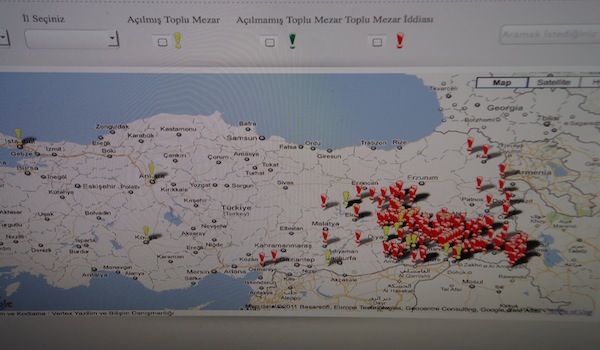 NEWSDESK, — IHD Amed (Diyarbakir) branch has presented a new report on mass graves in Turkey which the update released last February. According to the report there are at least 3,248 bodies buried in 253 separate mass graves.
NEWSDESK, — IHD Amed (Diyarbakir) branch has presented a new report on mass graves in Turkey which the update released last February. According to the report there are at least 3,248 bodies buried in 253 separate mass graves.
The map of the mass graves can be found at: (www.ihddiyarbakir.org). It is the first interactive map of the mass graves in Turkey. Realised by the Human Rights Association (IHD) it has been presented to the public and press some days ago.
IHD secretary Bilici suggested that most of the 40 thousand war victims have no grave. Many militants and civilians who were killed by dark powers were buried in mass graves by state or military officers. Bilici mentioned the founder of the Gendarmerie Intelligence and Anti-Teror Unit (JITEM) Arif Dogan’s statement; “do really expect us to bury them in real graves? Surely, we buried them in mass graves.”
Bilici said, “The inhuman practices in 90s are violations of international conventions, human rights and human honor.”
Bilici asserted that the report relies on real testimony and knowledge. He credits the first report, which was released on February, 11, 2011, with leading to many more notices and investigations. “This new report has three times as much data about mass graves,” the IHD secretary said. At the end of his speech, he called on government and all nongovernmental organizations to deal with these mass graves.
There has been a deafening silence from the Turkish state with regard to the discovery of graves. The debate about mass graves is particularly intense following the discovery of a mass grave containing the bones of at least 12 people on 5th January at Mutki, a city of the province of Bitlis, in connection with an investigation of the fate of 38 Kurds who have been missing for many years. Dozens of mass graves have been found by villagers since its discovery.
Despite requests from human rights organisations and the families of the missing for over two weeks, the prosecutor of Mutki, Cetin Kucet, is refusing to order the exhumation of one body in the presence of lawyers and human rights representatives.
Hasan Ceylan, the representative of the Association of Human Rights (IHD) in Bitlis, denounced the refusal as an “arbitrary” decision by the prosecutor who had blocked the process of exhumation. Leaving the defenders of human rights outside the area, excavations were carried out by village guards, armed and paid by the government in Ankara against the Kurdistan Workers’ Party (PKK), according to Ceylon. “We found that and the prosecutor does not want us on the place”, he said.
One of the mass graves was found near a gendarmerie station in the eastern province of Bitlis’ Mutki district. This is prime evidence of the complicity between the army and the Turkish government.
Atilla Kiyat, retired Vice Admiral said: “The unsolved political killings (Faili meçhul in Turkish) were a state policy between the years 1993 and 1997”.
Former JIITEM member Yıldırım Beggler stated that about 200 bodies are buried in a region which they have pretended is mined. Beggler, known as the General Staff translator, and who currently resides in Norway, told journalists that in the context of “unsolved” murders, many people were killed by torture, most of the bodies were burned in the boiler room of the Gendarmerie 2nd Border Division or thrown from helicopters. About 200 bodies were apparently dropped in the region of the Hezil stream. He said: “Hezil Çayı is close to the Habur border crossing. The bridges no. 47 and 48 are in this region. Bridge no. 47 is used for entering Turkey form Iraq, the 48th bridge serves the opposite direction from Turkey to Iraq. Hundreds of executed people were thrown into the river between the two bridges within the boundaries of the 2nd Division, tied up to stones or other heavy objects. This is the largest area where executed bodies were buried. People think it is a mined region, but it is clear of mines. The region in a radius of 500-1000 metres around the 48th bridge between the Hezil stream and the Aktepe military zone is called ‘fire area’. We cleared the mines in this region and pretended that it was still a mined area. There is a stream here, it might be a side arm of the Hezil stream. 20-30 metres beyond the end of the stream, 80-90 people are buried”.
Şırnak Bar Association President Nuşirevan Elçi clarified that an application was made to the Diyarbakir special authority prosecution on 28th December upon Begler’s statement but the beginning of the procedure was delayed due to the weekend and New Year’s Eve.